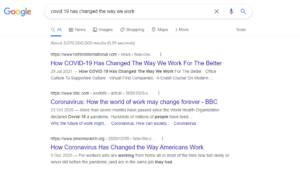How to Stop Writing Like a Robot
If everybody looked the same, we’d get tired of looking at each other. So said Groove Armada in their 1999 banger of the same name. Now, if you’ll bear with me, that line of the song is relevant to this article for two reasons. Firstly, because if every bit of copy looked the same, we’d get tired of looking at it. And secondly, because it’s unlikely a writing bot would choose to quote a seminal 90s British electronic group in the first line of an article about copywriting. And yet, how many blogs do you see every day that could’ve been written by the same person? Or by a bot? The worst thing is, you can start slipping into generic cliches and vanilla copy without even realising it. With that in mind, here are a few tips to help prevent you from writing like a robot and churning out copy that looks the same. We wouldn’t want your readers to get tired of looking at it, after all. So, here’s a few tips and tricks from a professional SEO copywriter.
Table of Contents
Think of an Original Introduction
 ‘The COVID-19 pandemic has changed the way we work.’
‘The COVID-19 pandemic has changed the way we work.’
No, No, No. Stop. Stop what you’re doing immediately.
This opening sentence – or variants thereof – has probably been written more times than there have been COVID cases. And to be honest, when this pandemic kicked in it was quite a nice start to an article. I definitely used it a few times. But it can quickly become a cliche. At this point, it’s about as contentious as the idea that the wheel changed the way we travel.
Simply put, it just isn’t a sentence that catches the reader’s eye and hooks them in – especially when you’re competing against 3,100,000,000 other Google results.
So the next time you’ve polished off your piece of copy and are about to hit publish, double-check the intro. Does it grab the reader’s attention? Is it unique? Is it different? Try using things like statistics, jokes, puns, obscure references – anything that makes your content stand out in a sea of search results.
Just don’t tell me that COVID-19 has changed the way we work.
Read your Copy Out Loud
Do you know the thing about writing bots? They write like bots. Yes, they are getting better. Yes, someday they may overpower us and become our ruling masters. But that day is not today.
It’s difficult to carve out your own written tone of voice. Every language is bound by rules that you have to stick to – whether that’s spelling, grammar or – more so nowadays – SEO. But here’s the thing. Every person has their own tone of voice. Every person has their own way of talking, with their own mannerisms, and certain words they like to use more than others. And they use that unique tone of voice on a daily basis, in every interaction they have. For you, the key is just translating your unique tone of voice to the page.
The next time you write a piece of copy, read it out loud back to yourself. Does it sound right or coherent? And does it sound like you? If not, it’s time to go back and rewrite it until you can be sure it does. That’s the best way to establish a tone of voice that is noticeably different to everyone else.
Don’t get Obsessed with SEO
I really feel like there’s an enormous-grey-thing-with-a-trunk in the room that needs addressing.
SEO.
You may well have written a catchy intro for an article that’s in a totally unique tone of voice. And you may well be very happy with said article. But then disaster strikes. You didn’t include this keyword enough times in the piece. Your sentences are on average THREE words too long! And our totally arbitrary reading test only considers this article OKAY to read!! Well, time to rewrite I guess.
Actually, no. When you’re writing content for the web, your priority should always be writing content that meets and exceeds the reader’s expectations. It should answer the question they’re posing, give them the information they’re looking for or solve their problem. So don’t get too caught up with so-called SEO best practices.
If you’re being told you need to insert the target keyword into your article for the fourth time, and it just doesn’t fit, don’t disrupt the flow of your article to shoehorn it in. That’s the kind of thing Google actively penalises and makes it even less likely that readers will ever find your content.
Of course, you can’t ignore SEO rules entirely. You’ve got to let Google know what your article is about, and obviously, that includes using certain keywords within it. So give Google the right indicators – and then focus on the reader. Give them the information they’re looking for in the most effective way possible.
Use Writing Tools Sparingly
My final tip for not writing like a robot is, funnily enough, to reduce your reliance on robots.
There are a lot of writing tools and assistants out there; some good, some bad. I’ve even bigged one of them up in a previous post. But the key is to use them sparingly. The Hemingway Editor, for example, is probably going to make A LOT of recommendations the first time you run your copy through it. Don’t listen to all of them. Use your common sense, and draw upon your own writing expertise to figure out which suggestions are a good idea, and which are not.
I say that because we’re now arriving back at where we started with this article, and the prescient words of those philosophers, Groove Armada. If everybody looked the same, we’d get tired of looking at each other. If everybody made the same changes that Hemingway Editor recommended, we would surely start seeing the same copy everywhere.
In summary, use these writing tools to your advantage and don’t just blindly follow their advice. Use them to iron out the creases in your writing, but don’t use them to iron out the personality in your writing. Because it’s that personality you inject into each and every piece that separates us from the bots. If all else fails, why not hire a copywriter who knows a little about SEO.
Continue Reading: What are the best practices to avoid the problem of duplicate content?
About the Author
Nick Harland is the founder of Big Bang Copy, a copywriting agency that does things differently. He writes about all things copywriting – for anyone that cares to listen! Feel free to connect with him on LinkedIn for more writing tips.




